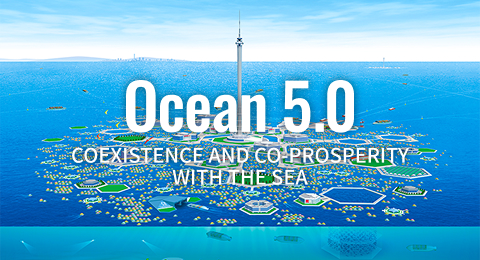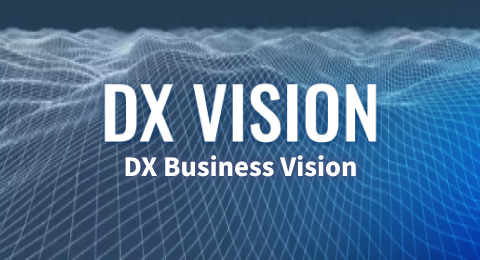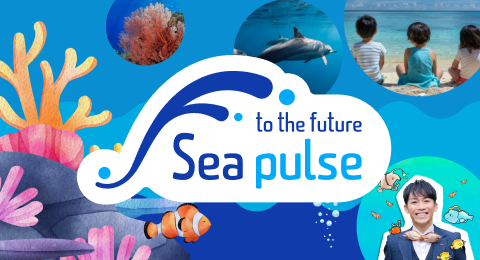20253.21
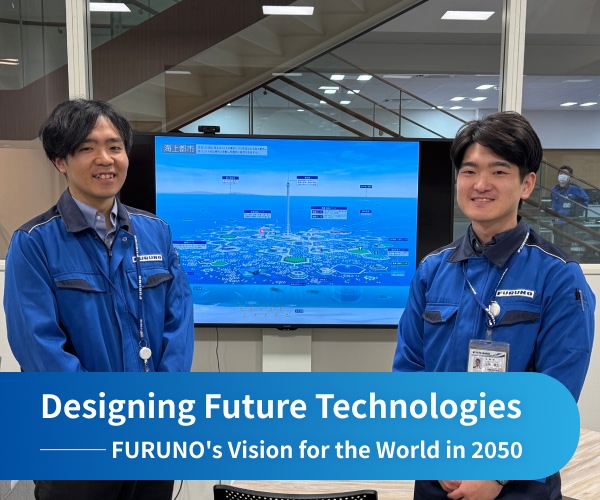
Designing Future Technologies — FURUNO's Vision for the World in 2050
Imagining the future and exploring the potential of new technology — This is the challenge in which the Furuno Electric Future Technology Design Committee engages daily. In this interview, we spoke to two people at the core of that process, Naohiro Kanemaru and Ryota Nagaoka, and asked about how they put into visual terms the future envisioned by the Future Technology Design Committee.
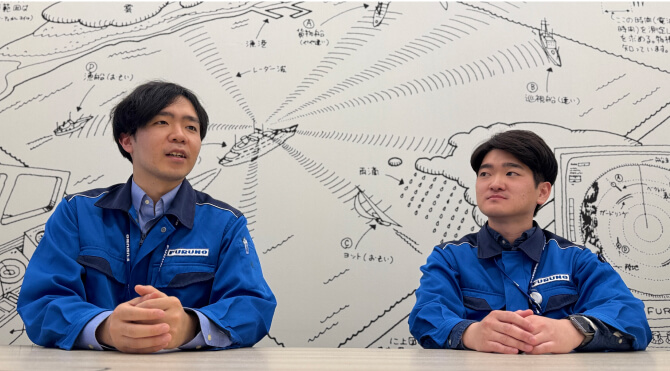
(Left) Naohiro Kanemaru
Hired in 2020. Autonomous Navigation Technology Development Department. In charge of VR navigation system development.
(Right) Ryota Nagaoka
Hired in 2020. Research & Development Department, Avionics and Defense Electronics Division. In charge of underwater sonar equipment.
It all started from the words: "Think of a bridge to ships in 2050."
—How did the Future Technology Design Committee start?
Kanemaru: It all started from the words from our department head, "Think of a bridge to ships in 2050." But this was more than merely about creating a bridge. It developed into the fundamental question of, "What will society actually be like in 2050?"
The first meeting of the Future Technology Design Committee was held in 2022. 10 young engineers from various departments like the Research Department, Marine Electronic Products Division, and System Products Division gathered together. At that time, we wanted to envision the future on a large scale, and the concepts of a future of living on the ocean and sustainable marine cities were born. In addition to engineers, we also had help from designers in putting a future vision into visual terms.
—Why was it necessary to establish a separate Future Technology Design Committee?
Kanemaru: When envisioning the future as an engineer, there is a tendency to default towards a specialist viewpoint a bit too much, so I felt that there was a need to conduct this in a format that made it easy to share our ideas with other departments.
Also, I wanted to make the Committee into a forum where everyone could get excited thinking about the future together, and say things like, "Wouldn't it be cool if the company was like, or like that, in 2050?" If the leaders of the next generation inherit this activity, I think that from technological development to sales, everyone will be advancing together in the same direction.
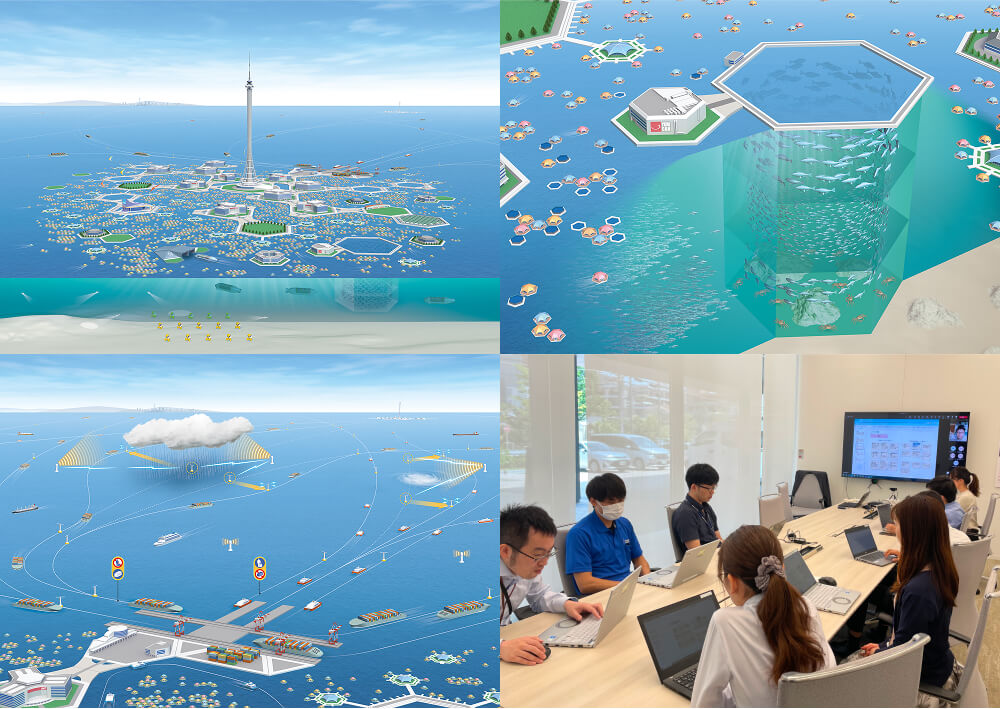
–What kinds of things did you think about in the second Future Technology Design Committee meeting?
Nagaoka: I started participating from the second meeting onward, and in the second meeting, a light was shone on a more concrete "world of 2035," and we organized the technology that would be necessary to actualize the future of 2050.
For example, we had discussions about themes like, "If completely auto controlled vessels are to become the norm by 2050, what level do we need to have advanced to by 2035?" and, "How is energy supply going to be handled in a marine city?" And that led naturally to discussions like, "The usage of renewable energy will be necessary, " and, "The advancement of AI and sensor technology holds the key."
—What was the difference between the first and second meetings?
Kanemaru: The first meeting focused mainly on a form to freely think about an exciting future. I felt that, for the second meeting, there was a stronger emphasis on the practical question of, "In order to head towards that future, what are the things we have to do now?"
Nagaoka: Yes, that is true. We first envisioned our ideal 2050, and then calculated backwards from that, asking the question of, "Okay then, how far do we have to advance by 2035?" By envisioning a closer future, it was easier to lead to an actual technological roadmap.
In addition, we also discussed the changes in societal values and lifestyles that would be needed in 2050. I felt it was good that we could have a discussion that focused not only on technology, but also on changes in society as a whole, such as the usage of renewable energy as a response to climate change and the introduction of auto ship control systems through AI.
Come up with out-of-the-box ideas! The challenge of envisioning the future
—Were there any areas that were difficult in the process of putting forth ideas?
Nagaoka: Engineers tend to have overly realistic perspectives. But when you are envisioning the future, I think that is not necessarily helpful, so instead I intentionally tried to steer people to giving ideas that are outside of the box. For example, we had discussions that are just way too "out there" when compared to normal ways of thinking, including ideas like using sonic waves that fish do not like instead of nets for fish farm-raising, and technology to lure fish using underwater drones. But the thing is, the seeds for new technology are born from those kinds of ideas.
Or, because future sea cities are always being impacted by waves, the issue of what to do to suppress the jolting came up. To address this, someone even mentioned something like, "We could put rocks inside people's ears to adjust the impact to the semicircular canals of the ear." In this way, by mixing together technology and ideas, the image of a new future kept expanding, and that was very interesting.

From idea to reality! Impact on future design and achievability
—How are the ideas that were generated being used?
Kanemaru: Actually, a few of the ideas generated in the Future Technology Design Committee are already linking to collaborations with external partners. For example, research into blue carbon (marine environment restoration) is progressing, and we are receiving requests for cooperation to solve the problem of sludge in harbors.
Furthermore, the ideas are influencing our technology roadmap, and the directionality of new technological development is becoming clearer and clearer. Ideas generated in the Future Technology Design Committee have become a common language throughout the entire company, and we are seeing an increase in cases where they link to the next project.
Nagaoka: I believe that this rises above the level of mere research and development, and fulfills the role of showing the directionality for the entire company. And some of the ideas considered in the Committee have actually already become a reference in project launching.
In particular, ideas for cities on the sea and farm-raising systems using underwater drones are easy to tie into actual technological development, and movement to explore the potential for actualizing these technologies in the real world has already arisen.
—From an engineer's perspective, what is the significance of this activity?
Kanemaru: Thinking about the future not only clarifies the directionality of technology, it also links to motivation within the company. Feeling that our technology might be able to change the future changes the way people approach their daily tasks.
Nagaoka: That is true. Furthermore, a major merit is the generation of ideas not yet seen in technological development. I got a sense in real-time of new potential expanding rapidly by the process of engineers freely coming up with new ideas through the Future Technology Design Committee.
Envisioning the future of 2050 — Creating the everchanging norm
—Please tell us about the 2050 future the two of you envision and your upcoming activities.
Kanemaru: What I am aiming for is creating the new norm of the future. In 2050, I want the world to be one in which using technology generated by FURUNO is the norm. In the process of thinking about the future, the answers are still undetermined, and because they are constantly changing, there is good reason to continue this process.
What enabled us to engage in this activity was the fact that everyone up to now has sturdily solidified the foundation for us. It is because everyone has gotten rid of waste and generated profit that we have the space to think about the future. We have received this chance to create a new future based on those profits, so I want to work hard on this process.
Nagaoka: By 2050, I think uncrewed crafts will be in use across all domains: the land, the sea, and the sky, and the world will be one in which sensor technology supports this. But in order to actualize that vision, I feel that it is important for there to be more people who can think about the future instead of technology alone.
Technological development is not something that advances along a single path, but instead a process of all sorts of buds spring from stems. Developers hold these stems firmly and generate new technology. I want to continue dreaming about an exciting future while preserving that balance.
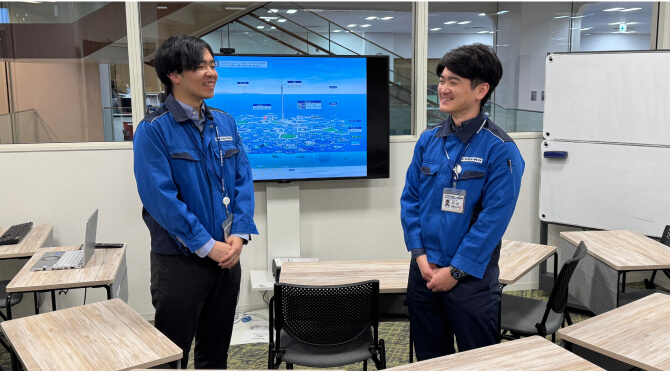
It is because the future constantly changes from the moment you envision it that continuing to think about it has meaning. That is the impression I felt strongly from the words of these two interviewees.





